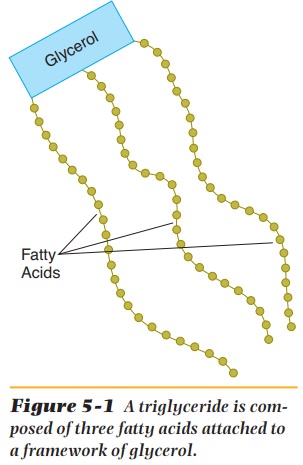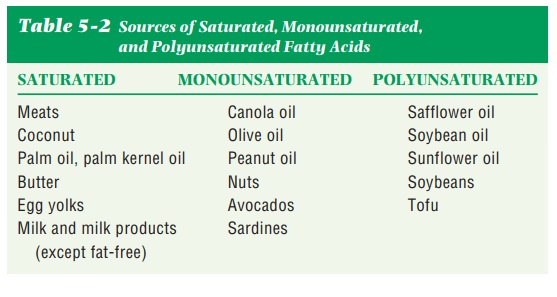Chapter: Nutrition and Diet Therapy: Lipids or Fats
Classification of Lipids or Fats
CLASSIFICATION
Triglycerides, phospholipids, and sterols are all lipids found in food
and the hu-man body. Most lipids in the body (95%) are triglycerides. They are
in body cells, and they circulate in the blood.
Triglycerides are composed of three
(tri) fatty acids attached to aframework of glycerol, thus their name
(Figure 5-1). Glycerol is derived from a water-soluble carbohydrate. Fatty acids are organic compounds
of carbon atoms to which hydrogen atoms are attached. They are classified in
two ways: essential or nonessential. Essential
fatty acids (EFAs) are necessary fats that humans cannot synthesize; EFAs
must be obtained through diet. EFAs are long-chain polyunsaturated fatty acids
derived from linoleic, linolenic, and oleic acids.
There are two families of EFAs: omega-3 and omega-6. Nec-essary, but
nonessential, are the omega-9 fatty acids because the body can manufacture a
modest amount, provided EFAs are present.

The other method of
classification of fatty acids is by their degree of satu-ration with hydrogen
atoms. In this method, they are described as saturated,monounsaturated, or
polyunsaturated, depending on their hydrogen content(Figure 5-2).

Saturated Fats
When a fatty acid is saturated, each of its carbon atoms carries all the hydrogen atoms possible. In general, animal foods contain more saturated fatty acids than unsaturated. Examples include meat, poultry, egg yolks, whole milk, whole milk cheeses, cream, ice cream, and butter. Although plant foods generally contain more polyunsaturated fatty acids than satu-rated fatty acids, chocolate, coconut, palm oil, and palm kernel oils are exceptions. They contain substantial amounts of saturated fatty acids. Foods containing a high proportion of saturated fats are usually solid at room tem-perature. It is recommended that one consume no more than 7% of total daily calories as saturated fats.
Monounsaturated Fats
If a fat is monounsaturated, there is one place
among the carbon atoms of its fatty acids where there are fewer hydrogen atoms
attached than in saturated fats. Examples of foods containing monounsaturated
fats are olive oil, peanut oil, canola oil, avocados, and cashew nuts. Research
indicates that monounsaturated fats lower the amount of low-density lipoprotein
(LDL) (“bad cholesterol”) in the blood, but only when they replace saturated
fats in one’s diet. They have no effect on high-density lipoproteins (HDLs)
(“good cholesterol”). It is recommended that one consume 15% of total daily
calories as monounsaturated fats (Table 5-2).

Polyunsaturated Fats
If a fat is polyunsaturated, there are two or more places among the carbon atoms of its fatty acids where there are fewer hydrogen atoms attached than in saturated fats. The point at which carbon-carbon double bonds occur in a poly-unsaturated fatty acid is the determining factor in how the body metabolizes it. The two major fatty acids denoted by the placement of their double bonds are the omega-3 and omega-6 fatty acids. Omega-3 fatty acids have been reported to help lower the risk of heart disease. Because omega-3 fatty acids are found in fish oils, an increased intake of fatty fish is recommended.
Omega-6 (linoleic acid) has a
cholesterol-lowering effect. The use of supplements of either of these fatty
acids is not recommended. Examples of foods containing polyunsaturated fats
include cooking oils made from sunflower, safflower, or sesame seeds or from
corn or soybeans; soft margarines whose major ingredient is liquid vegetable oil; and fish. Foods
containing high proportions of polyunsaturated fats are usually soft or oily.
Polyunsaturated fats should not exceed 8% of total daily calories.
Trans-Fatty Acid
Trans-fatty acids (TFAs) are produced when hydrogen
atoms are added tomonounsaturated or polyunsaturated fats to produce a
semisolid product like margarine and shortening. A product is likely to contain
a significant amount of TFAs if partially hydrogenated vegetable oil is listed
in the first three ingredients on the label. The major source of TFAs in the
diet is from baked goods and foods eaten in restaurants. TFAs raise LDLs and
total cholesterol.
Hydrogenated Fats.Hydrogenated fats are polyunsaturated
veg-etable oils to which hydrogen has been added commercially to make them
solid at room temperature. This process, called hydrogenation, turns polyunsaturated
vegetable oils into saturated fats. Margarine is made in this way. (Soft
margarine contains less saturated fat than firm margarine.)
Related Topics